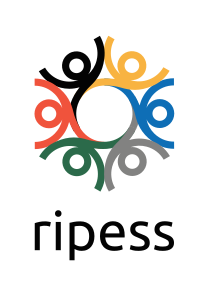
Extracts of the Global Vision for a Social Solidarity Economy: Convergences and Differences in Concepts, Definitions and Frameworks paper released by RIPESS in 2015 as part of a process of dialogue conducted between the continental member networks since 2013.
The vision of SSE has been steadfast, but underlying concepts, definitions and frameworks have, and continue to evolve.
The social economy is commonly understood as a “third sector” of the economy, complementing the “first sector” (private/profit-oriented) and the “second sector” (public/planned). The third sector includes cooperatives, mutuals, associations, and foundations (CMAFs). These entities are collectively organized and oriented around social aims that are prioritized above profits, or return to shareholders. The primary concern of CMAFs, as societies of people, is not to maximize profits, but to achieve social goals (which does not exclude making a profit, which is necessary for reinvestment). Some consider the social economy to be the third leg of capitalism, along with the public and the private sector. Thus, advocates of the social economy push for it to be accorded the same legitimacy as the public and private sectors, with a corresponding level of support in public resources and policy. Others, on the more radical end of the spectrum, view the social economy as a stepping stone towards a more fundamental transformation of the economic system.
The solidarity economy seeks to change the whole social and economic system and puts forth a different paradigm of development that upholds solidarity economy principles. It pursues the transformation of the neoliberal capitalist economic system from one that gives primacy to maximizing private profit and blind growth, to one that puts people and planet at its core. As an alternative economic system, the solidarity economy thus includes all three sectors – private, public and the third sector.
A comparison of the definition of social enterprise used by social enterprise associations in the UK, the US, Europe and Canada, shows that they have the following features in common: 1) the enterprise serves a social aim such as fighting poverty or social exclusion 2) it primarily generates income based on the sale of goods and services rather than depending on grant funding and 3) profits are reinvested in the social mission rather than maximizing value for stockholders.
Where the definitions differ is in terms of ownership and control. The stockholder form vests control with owner(s), whether it is an individual or a group investors that purchased shares in the enterprise. In this case, control is accorded to capital – the amount of money that has been invested in the enterprise. The stakeholder form vests control in some collective of those that have an invested interest or stake – not only a monetary one – in the enterprise. This could include the workers, the community, the beneficiaries, or a non-profit organization.
Whereas the UK and US associations include both the stockholder and stakeholder forms of ownership/control, the European and Canadian associations restrict their definition to include only the stakeholder form.
SSE embraces the concept of the Rights of Mother Earth which is embedded in the “buen vivir” (living well) paradigm and draws heavily on indigenous visions of humans living with respect for and in harmony with Mother Earth as opposed to having simply a utilitarian relationship. It must be clear that “buen vivir”is not a “model” to be generalized. Its expression changes from community to community, culture to culture, nation to nation. Nonetheless, its different expressions tend to be firmly related to, and rooted in, key elements (both material and immaterial, measurable and unmeasurable), such as: community bonds, culture, access to land, access to means of production and infrastructure, high levels of participation and effective involvement of community about their future, food sovereignty, peace, gender equity, biodiversity, healthy environment, etc.
SSE questions the assumption that economic growth is always good and states that it depends on the type and goals of the growth. For SSE, the concept of development is more useful than growth. For example, human beings stop growing when they hit adulthood, but never stop developing.
SSE should engage in the advancement of indicators that shift the emphasis away from growth and towards development and “buen vivir“. SSE needs measures that can lift up the value of not only physical resources (eg. land, water) but also non tangible assets such as happiness, mental, workplace and social wellness, indigenous knowledge, non-monetized work, and so forth.
Development must prioritize the environment, and the redistribution of power and wealth between rich and poor. SSE seeks to create economic development that is equitable in its own right, as opposed to economic development that generates great inequality even if it is subsequently lessened through re-distribution.
Rural development is of particular importance for the welfare of these communities, in addition to being critical to reducing forced migration. For example, the state should protect SSE initiatives such as community forest management in Nepal and India from big corporate domination.
In their concern for an approach and practices that go beyond growth as the dominant framework, SSE and the degrowth movement share some potential grounds for convergence. However, degrowth is a concept that warrants further discussion within the SSE movement in order to develop a clearer shared understanding.
Commons are resources, both natural and socially created that are collectively managed for the benefit of a community or the earth. Natural commons include for example, clean air and water, though these are increasingly being privatized or used for private gain.
Socially created commons include things such as language, folk tales and Wikipedia. Thus the commons does not refer only to the protection of the environment, but also to social resources that support basic rights to health, education, equity and diversity.
There are varying levels of comfort with concepts such as social enterprise and corporate social responsibility. This is complicated by the fact that different countries have different definitions of these terms.
Corporate social responsibility (CSR) practices and discourse aim to integrate an ethical approach into corporate practices and in theory, can be consistent with SSE values. In practice, while there are many examples of CSR that are commendable, there is a very real danger that CSR is used as a public relations tool. Corporations such as Coca-Cola and Shell Oil brand themselves as champions of sustainability, local economic development, and community empowerment while at the same time engage in practices that are harmful to workers, the environment, local communities, small businesses and family farmers.
Another risk is that the voluntary CSR framework is given preference by governments and corporations over the adoption and enforcement of a human rights approach based on legal obligations. SSE actors should take advantage of opportunities for fruitful CSR partnerships when realized in conditions of equality, but must be careful of cooptation.


